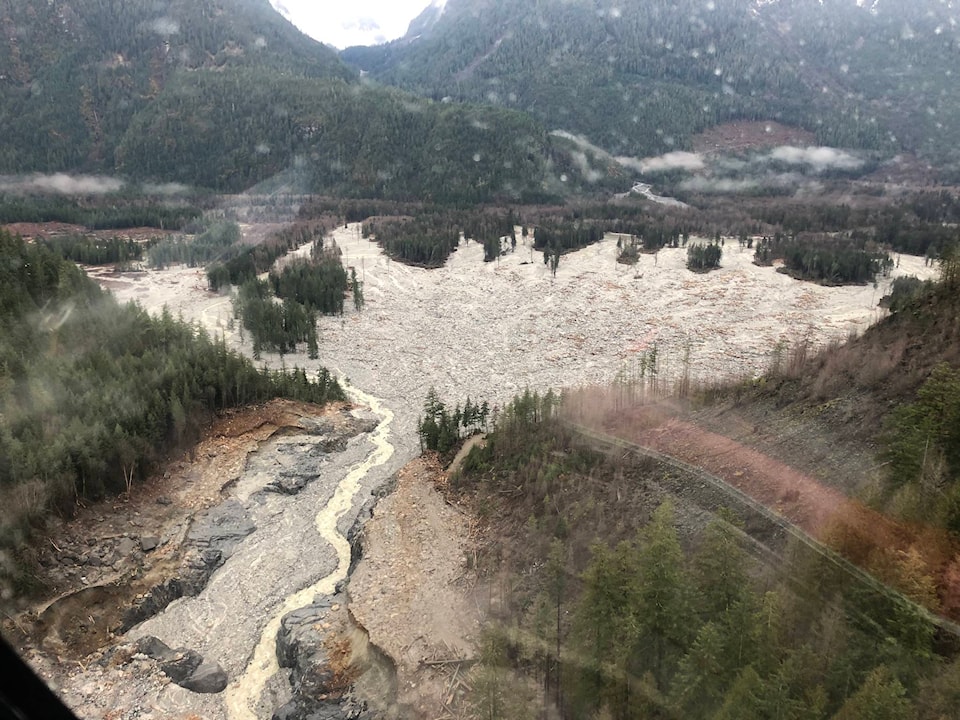Chief Darren Blaney expects the worst for a generation of coho and chum salmon mowed down in the Southgate River by a massive landslide last month on B.C.’s south-central coast.
“With the speed and violence of this devastation, we expect all the eggs were washed out,” said the Homalco First Nation leader. “It really gouged out the mountainside when it came down. The boulders are pretty big. Just the momentum of it; it took out all the trees and the inlet is now just full of debris.”
The landslide originated in the Coast Mountains near Elliot Creek, tearing into a glacier and plunging ice and forest debris into a swollen glacial lake. A powerful outburst flood generated a wave reaching between 70 and 110 metres tall, turning to the Southgate River and bulldozing its way to the head of Bute Inlet.
The event occurred late November, but due to its remote location the impacts are only now coming to light.
READ MORE: 100 metre wave causes massive washout in coastal B.C. inlet
Blaney is meeting with the provincial government this afternoon (Dec. 15), and planning an aerial tour of the area tomorrow with Fisheries and Oceans Canada officials.
With only one bridge washed out, and no known human life lost, Blaney said his attention is fixed on salmon recovery. The nation’s Orford hatchery will be requesting a special permit from the province to replace the salmon losses.
“We’ll see what supports we can get to rebuild the stocks, enhance them at Southgate,” Blaney said.
Brent Ward, co-director for the Centre for Natural Hazards Research at Simon Fraser University, said the waterways will eventually re-establish their paths, but the landslide will have a serious impact on fish.
“The lower reaches of Elliot Creek are Coho habitat, and if you look at those images, that habitat is now buried with gravel,” he said.
“These landslides happen, but when you’re dealing with a four-year life cycle of a fish, it’s going to have a longer effect than that.”
Blaney said the losses will factor into consultations alongside six other First Nations with the federal government over the fate of salmon farming in the Discovery Islands.
The narrow waters form a bottleneck for out-migrating juvenile salmon, which opponents to open-net pen farms fear increases the potential for sea lice and parasite transmission. Fisheries Minister Bernadette Jordan is expected to decide this month whether to renew the licences of 18 farms in the area.
“We’re waiting for a decision, but this landslide will only add to the urgency to get those farms on land,” Blaney said.
A 2020 prohibition on salmon farming in the Discovery Islands was recommended in the 2012 Cohen Commission report, which looked into the collapse of Fraser River sockeye, if the salmon farms presented more than a minimal risk to wild stocks.
DFO risk assessments showed the farms were operating within acceptable limits.
Nonetheless, while the consultations have focused on sockeye salmon, Blaney said all species are still potentially impacted by the salmon farms. With a generation of chum and coho wiped out by the landslide, he will push for their inclusion in consultations.
“The stocks that are passing by Johnstone Strait are becoming less and less reliable,” Blaney said. “We’ve been working hard at Orford so we can create our own food security, that we’ll have enough chum stocks for our own community, but also so we can look after our elders, pass on knowledge and hang on to our culture.”
- with files from Marc Kitteringham
